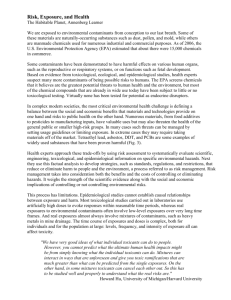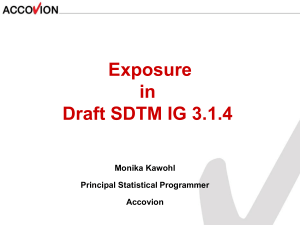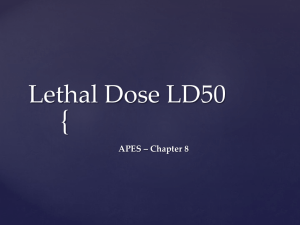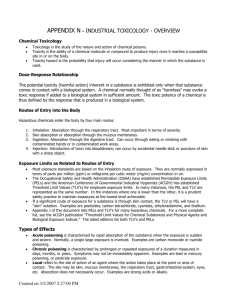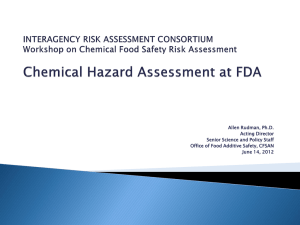The Dose Makes the Poison—Or Does It
advertisement
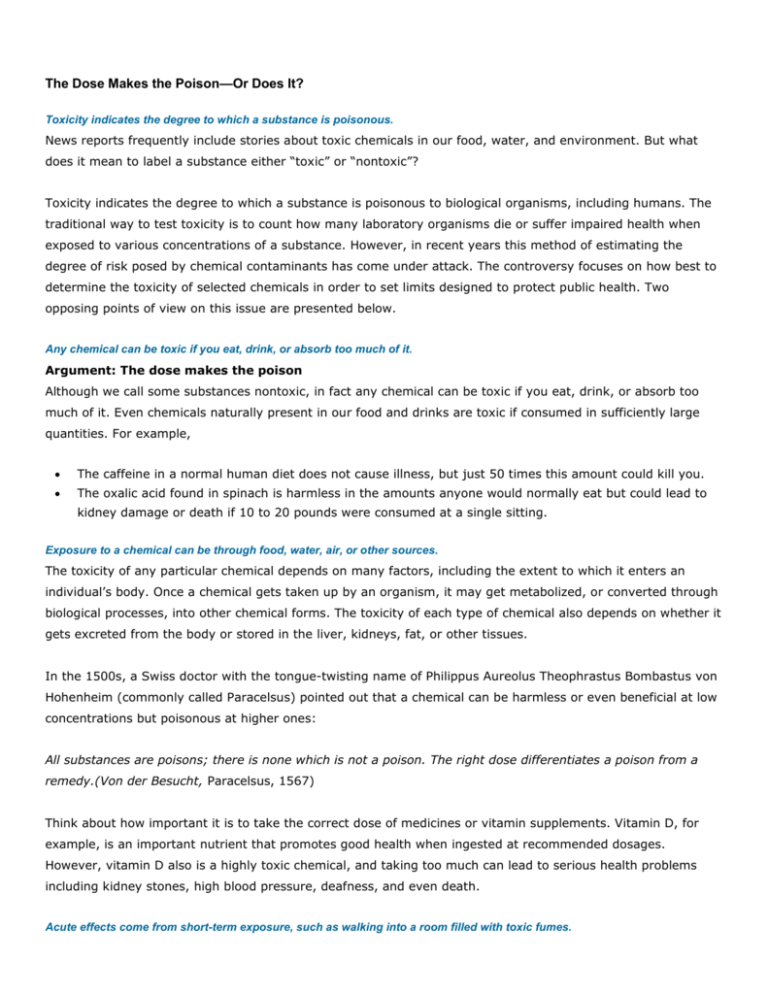
The Dose Makes the Poison—Or Does It? Toxicity indicates the degree to which a substance is poisonous. News reports frequently include stories about toxic chemicals in our food, water, and environment. But what does it mean to label a substance either “toxic” or “nontoxic”? Toxicity indicates the degree to which a substance is poisonous to biological organisms, including humans. The traditional way to test toxicity is to count how many laboratory organisms die or suffer impaired health when exposed to various concentrations of a substance. However, in recent years this method of estimating the degree of risk posed by chemical contaminants has come under attack. The controversy focuses on how best to determine the toxicity of selected chemicals in order to set limits designed to protect public health. Two opposing points of view on this issue are presented below. Any chemical can be toxic if you eat, drink, or absorb too much of it. Argument: The dose makes the poison Although we call some substances nontoxic, in fact any chemical can be toxic if you eat, drink, or absorb too much of it. Even chemicals naturally present in our food and drinks are toxic if consumed in sufficiently large quantities. For example, The caffeine in a normal human diet does not cause illness, but just 50 times this amount could kill you. The oxalic acid found in spinach is harmless in the amounts anyone would normally eat but could lead to kidney damage or death if 10 to 20 pounds were consumed at a single sitting. Exposure to a chemical can be through food, water, air, or other sources. The toxicity of any particular chemical depends on many factors, including the extent to which it enters an individual’s body. Once a chemical gets taken up by an organism, it may get metabolized, or converted through biological processes, into other chemical forms. The toxicity of each type of chemical also depends on whether it gets excreted from the body or stored in the liver, kidneys, fat, or other tissues. In the 1500s, a Swiss doctor with the tongue-twisting name of Philippus Aureolus Theophrastus Bombastus von Hohenheim (commonly called Paracelsus) pointed out that a chemical can be harmless or even beneficial at low concentrations but poisonous at higher ones: All substances are poisons; there is none which is not a poison. The right dose differentiates a poison from a remedy.(Von der Besucht, Paracelsus, 1567) Think about how important it is to take the correct dose of medicines or vitamin supplements. Vitamin D, for example, is an important nutrient that promotes good health when ingested at recommended dosages. However, vitamin D also is a highly toxic chemical, and taking too much can lead to serious health problems including kidney stones, high blood pressure, deafness, and even death. Acute effects come from short-term exposure, such as walking into a room filled with toxic fumes. The notion that “the dose makes the poison” provides the basis for public health standards, which specify maximum acceptable concentrations of various contaminants in food, public drinking water, and the environment. Setting such standards is a complicated process involving scientific research and public policy decisions. The first step typically is to assess a chemical’s short-term, or acute, toxicity. This is measured through dose-response experiments in which laboratory organisms are exposed to various doses of the test chemical. Dose refers to the amount of a substance that an organism eats, inhales, or absorbs through the skin. Collectively, these amounts make up the exposure of that organism to that particular substance. Response refers to the changes in living things caused by exposure to a substance. Typically, as the dose of a toxic substance goes up, increasing numbers of organisms die or show signs of impaired health. Chronic effects develop slowly from long-term exposure to contaminants. However, there is more to chemical toxicity than the acute effects caused by short-term exposure to high doses. In recent years, concern has grown about chronic effects of long-term exposure to relatively low doses of contaminants in our water, food, and environment. Because our bodies metabolize different types of chemicals in different ways, small daily doses of some contaminants will create cumulative effects that eventually impair our health, whereas similar exposure to other types of contaminants will cause no harm. Lead is an example of a chemical for which small doses can add up to toxic concentrations over time, resulting in stunted growth and mental retardation in children who drink lead-contaminated water or live in homes with peeling lead paint. Rather than occurring suddenly, chronic effects such as these develop gradually through long-term, low-level exposures. Drinking water standards address chemical exposures over an entire lifetime. One approach to protecting public health from acute and chronic exposures is to regulate maximum allowable concentrations of designated contaminants in water, food, and air. Under the federal Safe Drinking Water Act, for example, the Environmental Protection Agency (EPA) establishes maximum contaminant levels for a long list of chemicals potentially found in public water supplies. The goal is not only to protect the public from acute poisoning but also to ensure that contaminant concentrations remain low enough to provide protection over the course of a lifetime from chronic effects such as cancer, birth defects, or damage to the liver or other organs. The law presumes that for each contaminant there is a threshold concentration below which the water will be relatively safe to drink. Setting standards involves several steps: First, threshold concentrations are determined through dose-response experiments with laboratory animals. These indications of acute toxicity are coupled with a search for evidence of potential impacts of long-term exposure to low-level doses either in animals or humans. Because of the uncertainty inherent in translating between the measured effects of a chemical in laboratory animals and its estimated effects in humans, EPA applies a safety factor when calculating the acceptable dose. This safety factor ranges between 10 and 1000, depending on the degree of confidence that available data provide an accurate estimate of the chemical’s effects on human health. After determining the desired threshold concentration for each contaminant in public drinking water, EPA studies the technical and financial feasibility of providing water that meets this desired goal. Finally, EPA combines the results of health and feasibility studies to select a legal drinking water standard that comes as close as possible to achieving the health-based goal. A different process is used for chemicals that are known or suspected to cause cancer in humans. For carcinogens, data from animal experiments and human exposures are analyzed to determine whether a safe dose can be identified. If there is no dose below which the chemical is considered safe, the drinking water standard is set at the lowest concentration that can feasibly be achieved with available technology. Counterargument: It’s not that simple The idea that “the dose makes the poison” relies on the assumption that the higher the dose of any particular chemical, the greater its toxic effect on living organisms. However, this assumption is not always correct. The more we learn about the complex ways in which organisms interact with the chemicals to which they are exposed, the more difficult it seems to be to establish understandings that can be generalized across different types of organisms and chemical substances. We’re not all the same Species may respond in different ways to toxic chemicals. Some individuals are more sensitive to a particular chemical. Chemical sensitivities vary from one species to another, so the responses of laboratory test organisms may or may not accurately model those that occur in humans. Another problem with dose-response studies is that sensitivity to contaminants varies between life stages, both in humans and in other types of organisms. Immature individuals, including fetuses, infants, and children, show much greater sensitivities to some chemicals than do mature adults. In setting drinking water standards for noncarcinogenic substances, EPA uses an average adult male weighing 70 kilograms (154 pounds) who drinks two liters of water each day throughout a 70-year lifetime. Clearly we’re not all 70-kg adult males, but this generalization is used for calculation purposes. If any subgroup of humans is known to be particularly sensitive to the chemical in question, then the standard is set to protect the most sensitive part of the population. For example, the 10 milligrams/liter (mg/L) drinking water standard for nitrate is based on the fact that infants are more sensitive than adults to this substance. (Excess nitrate can cause “blue baby syndrome,” which lowers the ability of a baby’s blood to carry Excess nitrate in drinking water oxygen.) Ideally, all public health standards would be designed to protect the can cause blue baby syndrome. most sensitive segments of the population, but in reality we don’t yet know Photo: Microsoft Images enough about the chronic effects of most contaminants to tailor the standards in this way. Each chemical is different Some chemicals are particularly dangerous at extremely low doses. Another problem with the concept that the dose makes the poison is that not all chemical toxicities fit the expected pattern of results. In a typical dose-response curve, we would see greater toxic effects occurring with exposure to higher doses of a given compound. Regulators use this expected relationship when they set standards indicating the threshold concentrations below which contaminants are believed to cause relatively little harm. However, scientists have discovered that very low doses of some compounds can induce stronger toxic responses than much higher doses, even at the same life stage of the test organisms. Contaminants that mimic hormones are of concern for this reason. Hormones are chemicals produced by our bodies to stimulate or regulate functions such as growth, digestion, reproduction, and sexual function. Contaminants that mimic hormones can disrupt crucial life functions at doses much lower than those previously thought to be safe, especially in fetuses and children. Perhaps for compounds such as these the slogan should be “No dose is low enough.” Very low doses of other contaminants may be beneficial to some organisms. The picture becomes even more complicated when you consider that for a few contaminants, extremely low doses have been seen to cause beneficial rather than detrimental effects in test organisms. This is thought to be caused by the organisms’ adaptive response to stress. Even though higher doses cause harm, the low-level stress caused by extremely low doses appears to trigger cellular repair and maintenance, leading to beneficial outcomes such as reduced risk of certain types of cancer in laboratory animals. Although this sounds like good news, it is important to keep in mind that a chemical that is beneficial in one way may also be damaging in others. For example, although exposure to tiny doses of a contaminant might improve immune responses in healthy adult males, that same exposure potentially could harm children, pregnant women, or people with suppressed immune systems. Before deciding that exposure to low levels of any particular contaminant is a good idea, we would need to investigate the potential impacts of this exposure on health, growth, reproduction, and behavior of individuals at various life stages. Why does it matter? The simplest way to test chemical toxicity is to count how many test organisms suffer serious health effects or die when exposed to large doses. However, these acute toxicity measurements do not help regulators to determine what average daily exposure to this contaminant would be relatively safe over the course of many years. Chronic toxicity is difficult to measure because our bodies respond in a variety of ways to chemical exposures. For each contaminant of concern, we need to investigate many potential effects, addressing questions such as these: What are the probabilities that long-term, low-level exposures to this contaminant will cause cancer, asthma, or another disease? Does this substance damage cells or genetic materials? At what concentrations and at what life stages do measurable effects occur? What are the probabilities of birth defects, reduced growth rates, or other impacts in fetuses and children exposed to low doses of this contaminant? Is there any evidence of potential links between exposures at early developmental stages and health impacts later in life? What types of laboratory tests have been conducted, and to what extent do the responses of test organisms correspond with any known responses in humans? Does this substance exhibit any unexpected results at extremely low doses? There will always be scientific uncertainties about chemical toxicities. Additional research is needed to clarify the cause-and-effect relationships between chemical exposures and potential health impacts. For many contaminants, few studies have been carried out. In many cases, scientific evidence is complex, incomplete, and full of uncertainty. Continuing scientific studies will help us to better understand the complex interplay between biological organisms and the chemical contaminants in our food, drinking water, and the environment. More research is necessary, but more research will always be necessary. We will never fully understand how each of the countless contaminants to which we are exposed could affect human health. Policymakers therefore must set public health standards based on available scientific evidence while also deciding on priorities for funding new scientific research to address areas in which potential risks are highest and our current understandings are most uncertain. Invoking the Precautionary Principle The Precautionary Principle provides protection in the face of scientific certainty. You may have heard of the Precautionary Principle, an approach that developed in Europe to protect human health and the environment in the face of the many unanswered and answerable questions related to environmental and human health. The principle calls for implementation of preventative measures to protect environmental quality and public health in spite of scientific uncertainties. Rather than waiting until governmental agencies have set standards or written regulations, some U.S. municipalities, states, and other entities are invoking the Precautionary Principle to avoid the possibility of serious or irreversible harm even when scientific knowledge is incomplete or inconclusive. For example, in 1999 the Los Angeles Unified School District invoked the Precautionary Principle in their decision to limit pesticide use in schools. In 2003, San Francisco became the first U.S. city to adopt a Precautionary Principle ordinance, stating: Where threats of serious or irreversible damage to people or nature exist, lack of full scientific certainty about cause and effect shall not be viewed as sufficient reason for the City to postpone cost effective measures to prevent the degradation of the environment or protect the health of its citizens. Any gaps in scientific data uncovered by the examination of alternatives will provide a guidepost for future research, but will not prevent protective action being taken by the City. As new scientific data become available, the City will review its decisions and make adjustments when warranted. The Precautionary Principle does not change the scientific issues related to chronic and acute toxicity assessment. Instead, it establishes the idea that protective actions can and should be taken before definitive proof has been established of potential harm from use of any chemical with suspected toxic impacts on human or environmental health.
